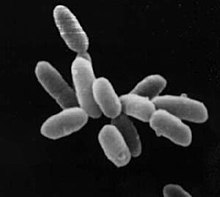User:Hedles/sandbox
| Archaea (Archaebacteria) Temporal range:
Paleoarchean or perhaps Eoarchean – recent
| |
|---|---|

| |
| Halobacterium sp. strain NRC-1, each cell about 5 μm long | |
| Scientific classification | |
| Domain: | Archaea Woese, Kandler & Wheelis, 1990[1] |
| Kingdoms[3] and phyla[4] | |
| |
| Synonyms | |
| |
Archaea (/ɑːrˈkiːə/ ⓘ or /ɑːrˈkeɪə/ ar-KEE-ə or ar-KAY-ə) constitute a domain of single-celled microorganisms. These microbes (archaea; singular archaeon) are prokaryotes, meaning they have no cell nucleus. Archaea were initially classified as bacteria, receiving the name archaebacteria (in the Archaebacteria kingdom), but this classification is outdated.[5]
Archaeal cells have unique properties separating them from the other two domains of life, Bacteria and Eukarya. The Archaea are further divided into multiple recognized phyla. Classification is difficult because the majority have not been isolated in the laboratory and have only been detected by analysis of their nucleic acids in samples from their environment.
URL[edit]
A typical URL could have the form http://www.example.com/index.html, which indicates a protocol (http), a hostname (www.example.com), and a file name (index.html). A Uniform Resource Locator (URL), commonly informally termed a web address (a term which is not defined identically)[6] is a reference to a web resource that specifies its location on a computer network and a mechanism for retrieving it. A URL is a specific type of Uniform Resource Identifier (URI),[7] although many people use the two terms interchangeably.[8] A URL implies the means to access an indicated resource, which is not true of every URI.[9][8] URLs occur most commonly to reference web pages (http), but are also used for file transfer (ftp), email (mailto), database access (JDBC), and many other applications. Most web browsers display the URL of a web page above the page in an address bar.
Trade unions[edit]
He joined NALGO in 1975. In 1990, he became the deputy general secretary. He was the UNISON's deputy general secretary (DGS) since its formation in July 1993, when it was formed from NALGO, NUPE and CoHSE.
UNISON leadership[edit]
In his role as the deputy general secretary, Prentis directed UNISON's national negotiating team and oversaw the union's policy making functions. He also drove through a strategic review of the union, aimed at delivering key reforms, to bring union services closer to the members.
Prentis is responsible for 1,500 staff and a turnover of around £160 million.[10]
He succeeded Rodney Bickerstaffe in 2001, having been elected in February 2000.
He is a member of the TUC general council, TUC executive committee and the Trade Union Labour Party Liaison Committee. Since 2007, he has been President of the TUC.[11] He is a member of the Labour Party's economy commission and the Labour Party joint policy committee.
Public organisations[edit]
He is a trustee of the Institute for Public Policy Research (IPPR) and also Catalyst, two centre-left research bodies.
Prentis is also an adviser to the Warwick Institute of Governance and Public Management and a visiting fellow of Nuffield College, Oxford. He is a member of various joint working parties with the government and the CBI. He is president of Unity Trust Bank and a director of the Bank of England.
- ^ Cite error: The named reference
Woesewas invoked but never defined (see the help page). - ^ a b "Taxa above the rank of class". List of Prokaryotic names with Standing in Nomenclature. Retrieved 8 August 2017.
- ^ Petitjean C, Deschamps P, López-García P, Moreira D (December 2014). "Rooting the domain archaea by phylogenomic analysis supports the foundation of the new kingdom Proteoarchaeota". Genome Biology and Evolution. 7 (1): 191–204. doi:10.1093/gbe/evu274. PMC 4316627. PMID 25527841.
{{cite journal}}: Unknown parameter|last-author-amp=ignored (|name-list-style=suggested) (help) - ^ "NCBI taxonomy page on Archaea".
{{cite journal}}: Cite journal requires|journal=(help) - ^ Pace NR (May 2006). "Time for a change". Nature. 441 (7091): 289. Bibcode:2006Natur.441..289P. doi:10.1038/441289a. PMID 16710401.
- ^ W3C (2009).
- ^ RFC 3986 (2005).
- ^ a b Joint W3C/IETF URI Planning Interest Group (2002).
- ^ RFC 2396 (1998).
- ^ Union boss Dave Prentis bags a 31% pension rise. Dailymail.co.uk. 30 July 2011 [dead link]
- ^ "New TUC President elected in Brighton". Trades Union Congress. 13 September 2007. Retrieved 31 July 2009.

